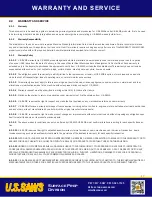
O P E R AT I O N
9
Figure 6
- Heavy Duty Dust Buggy SAWS blade depth setting
WARNING:
Beware that after releasing the lever, the blade will continue
spinning for several seconds. Keep a firm hold on the handle grips and
maintain control of the machine until the blade completely stops.
6.12
This machine is intended to be used with a vacuum with 200cfm
or more at all times. There is no instance where this machine should be
used without a vacuum or with water.
6.13
Determine how deep you want the blade in the joint. An 8”
blade will get a maximum of 2” depth and a 7” blade will get a maximum
of 1.5” depth.
6.14
The accurate way: Lay the saw on its side in the same position
you would to change the blade. Lower the blade until it is approximately
where you want it. Measure with a tape measure or ruler to confirm the
depth you want. Move the Brass “depth stop” thumb screw into the hole
that coincides with the depth adjustment to prevent the blade from being
lowered further than you want it. The “fine adjustment” knob on the left
side of the blade depth adjustment assembly can be screwed in or out to
make small adjustments to compensate for blade wear.
6.15
The quick way: With the saw “off”, lower the blade on a flat
surface lifting the front wheels off the ground. The distance between the
bottom of the wheel and the ground will be the approximate depth of cut
+/- 1/8”.
WARNING:
It is important to verify the depth of cut immediately after start-
ing, and periodically during the job. If you are cutting deeper than you
panned, you will use a lot more joint fill material than you had intended.
Surface Prep
Division
P: 877-817- 6687 F: 813-621-7125
Visit us at www.ussaws.com
sales@ussaws.com
SETTING THE BLADE DEPTH
6.1
Follow all pre-operating instructions in section 5.0.
6.2
The machine should be unplugged from electricity before start-
ing this operation. The blade will turn as soon as the Heavy Duty Dust
Buggy is turned on.
WARNING:
Never attempt to start the machine with the diamond blade
inserted in a joint or previous cut. The blade will turn as soon as the Heavy
Duty Dust Buggy is started. This could damage the blade or cause the
Heavy Duty Dust Buggy to jump backwards.
BLADE INSTALLATION:
6.3
Set the blade depth adjustment handle to the lowest point.
(See Figure 9)
6.4
Open the blade guard cover.
6.5
Loosen, counterclockwise, the blade nut and remove it along
with one of the two spacers. The inner arbor nut and one spacer will
remain in place.
WARNING:
If the blade you are using has a “5/8-7/8” knockout (brass
bushing), remove it so that the arbor of the blade is set at 7/8”
6.6
Ensure the proper direction of the blade being used. This ma-
chine rotates the blade in an up-cut rotation which is counterclockwise.
6.7
Place the blade on top of the spacer that is already on the ma-
chine and line up the arbor hole.
6.8
Place the Outer blade spacer on top of the blade and line up the
arbor hole.
6.9
Insert the shank of the Blade nut through the spacers and blade
and thread onto the shaft of the grinder and tighten the nut with moderate
force. Over tightening will cause problems when it’s time to change the
blade.
6.10
Raise the blade depth adjustment to it’s highest point, close
the blade guard cover plate. WARNING: Do not twist the blade in the cut.
Never attempt to cut any pattern or follow any joint that is not a straight
line. Do not force the blade forward. These actions could damage the
blade and Heavy Duty Dust Buggy unit.
WARNING:
Do not twist the blade in the cut. Never attempt to cut any
pattern or follow any joint that is not a straight line. Do not force the blade
forward. These actions could damage the blade and Heavy Duty Dust
Buggy unit.
6.0 OPERATIONS
CLEANING OUT EXISTING JOINTS:
VACUUM HOSE ATTACHMENT:
6.11
The vacuum port is designed to be used with the 2” cuff that is
standard on most industrial vacuums in the industry. The hose is meant to
have a snug fit to prevent it from falling off during normal operation. Some
hoses may require tape.




































